Experimental and Design Research on Seismic Performance of Connectors in Timber–Concrete Composite Structures
Abstract
1. Introduction
2. Experimental Investigation
2.1. Timber–Concrete Connection
2.2. Test Configuration
2.3. Loading Procedure
2.4. Failure Mode
2.5. Hysteretic Curve
2.6. Skeleton Curves
3. Seismic Performance
3.1. Stiffness Degradation
3.2. Strength Degradation
3.3. Energy Dissipation
3.4. Ductility
4. Damage Accumulation Assessment
4.1. Damage Assessment Principle
4.2. Physical Failure
5. Finite Element Simulation
5.1. Framework of FEA Model
5.2. FEA Results
5.2.1. Hysteretic Curves
5.2.2. Stress Contour
- (1)
- Concrete: Both connection types (S-1-16 and S-2-16) exhibit similar high-stress regions concentrated near the bolt (Figure 18a,b), consistent with the locations of observed concrete cracking and crushing during testing;
- (2)
- Timber: Significant differences exist in timber stress distribution between the two connection types. For the common bolt connection (S-1-16), the high-stress region extends extensively throughout the timber surrounding the bolt (Figure 18c). For the notch-bolted connection (S-2-16), the stress concentration is markedly reduced compared to S-1-16, and the stress level remains below the timber’s compressive strength (Figure 18d). This explains the experimental observation that the timber in notch-bolted connections remained intact (Figure 5h), as evidenced by the lower simulated stress;
- (3)
- Bolts: The stress distributions within the bolts are similar for both connection types. In both cases, a plastic hinge forms near the mid-length of the bolt (Figure 18e,f).
6. Suggestions for Seismic Design and Engineering Applications
- (1)
- Prioritize the use of notch-bolted connections. Tests have shown that the ultimate bearing capacity of notch-bolted connections is 15% to 30% higher than that of ordinary bolted connections with the same diameter. Moreover, the restraining effect of concrete on timber prevents timber crushing (no timber crushing was observed in the tests), making this type particularly suitable for regions with seismic fortification intensity ≥ 7 or structures subjected to reversed loads (e.g., bridges and gymnasiums);
- (2)
- Energy Dissipation and Ductility Control. The tests revealed that notch-bolted connections exhibit superior energy dissipation capacity compared to ordinary bolted connections of the same diameter. However, for smaller diameters (12 mm and 16 mm), the ductility of notch-bolted connections is inferior to that of ordinary bolted connections. Therefore, for smaller bolt diameters, ordinary bolted connections are preferred, but large-diameter or high-strength bolts should be avoided due to their poor ductility. In the tests, 16 mm bolts demonstrated better ductility (ξ = 3.6) compared to 20 mm bolts. For larger bolt diameters, notch-bolted connections are recommended due to their more stable ductility performance;
- (3)
- Damage Early Warning and Maintenance. Embed wireless displacement sensors near the connectors to monitor post-earthquake residual slip in real time and predict the cumulative damage factor (Dw). An early warning should be issued when Dw reaches 0.6;
- (4)
- Comprehensive consideration of seismic energy dissipation, damage, ductility control, and economic efficiency suggests the adoption of partial shear connection design. However, for partial shear composite beams, rational static design of shear connectors is required to ensure optimal utilization of the composite beam’s bearing capacity.
7. Summary and Conclusions
- (1)
- The failure mode of bolted connection specimens is characterized by concrete crushing at bolt holes and timber crushing, while notch-bolted connection specimens fail due to concrete crushing at bolt holes. The hysteretic curves exhibit an antisymmetric “S” shape with significant pinching effects;
- (2)
- The bearing capacity of bolted connection specimens increases with bolt diameter. For notch-bolted connection specimens, the bearing capacity improves with increasing bolt diameter initially, but further increases in diameter do not enhance capacity. For the same bolt diameter, notch-bolted connection specimens exhibit higher bearing capacity than ordinary bolted connections;
- (3)
- As bolt diameter increases, the ductility of bolted connection specimens first rises and then declines, while notch-bolted specimens show no significant change in ductility. For specimens with the same bolt diameter, bolted connections exhibit slightly better ductility than notch-bolted connections;
- (4)
- An ANSYS numerical model of the specimens under low-cycle reversed loading was established. Comparative analysis between numerical simulations and experimental results confirmed that the model accurately captures stiffness and strength degradation, validating its reliability;
- (5)
- Based on cumulative damage analysis, a correlation between specimen damage and the cumulative damage factor (Dw) was established. When Dw < 0.6, the specimen sustains moderate damage with no obvious signs; when 0.6 ≤ Dw < 0.7, the specimen is severely damaged; and when Dw ≥ 0.7, the specimen fails. Adhering to conservative evaluation principles, the critical damage index for joint failure is uniformly set at 0.6 and serves as the design basis.
- (6)
- Drawing upon the findings of Refs. [36,50], this study demonstrates a significant reduction in seismic risk: notch-bolted connections reduced the inter-story drift angle by approximately 17%. Furthermore, real-time monitoring ensuring Dw < 0.6 enables effective control of the residual deformation rate below 15%, thereby reducing repair costs by up to 38%.
- (1)
- The low-cycle reversed loading tests were conducted only on specimens with bolt diameters of 12 mm, 16 mm, and 20 mm. Factors such as bolt penetration depth into timber, variable amplitude loads, multi-material combinations, and environmental influences were not considered. Moreover, the test data are relatively limited, and the notch type was restricted to circular notches. Thus, the conclusions lack universality;
- (2)
- The ANSYS numerical model employed simplifications, leading to deviations in simulating the pinching effects of hysteretic curves. Future numerical analyses could utilize more accurate timber constitutive models (e.g., ANISO) or refined elements (e.g., spring elements) to simulate bolt-concrete (or timber) interactions;
- (3)
- The conclusions are specific to Northeast China larch glulam. The performance of other timber species (e.g., spruce/pine) requires further validation;
- (4)
- The current quantitative findings are based on laboratory specimens. Practical building performance must be verified through integrated structural models;
- (5)
- To investigate the impact of high-cycle fatigue loads in seismic environments, future studies could explore coupled seismic-fatigue damage mechanisms;
- (6)
- Development of sensor-based early warning systems, with a focus on cost analysis and field deployment, is recommended.
Author Contributions
Funding
Data Availability Statement
Conflicts of Interest
Correction Statement
Appendix A
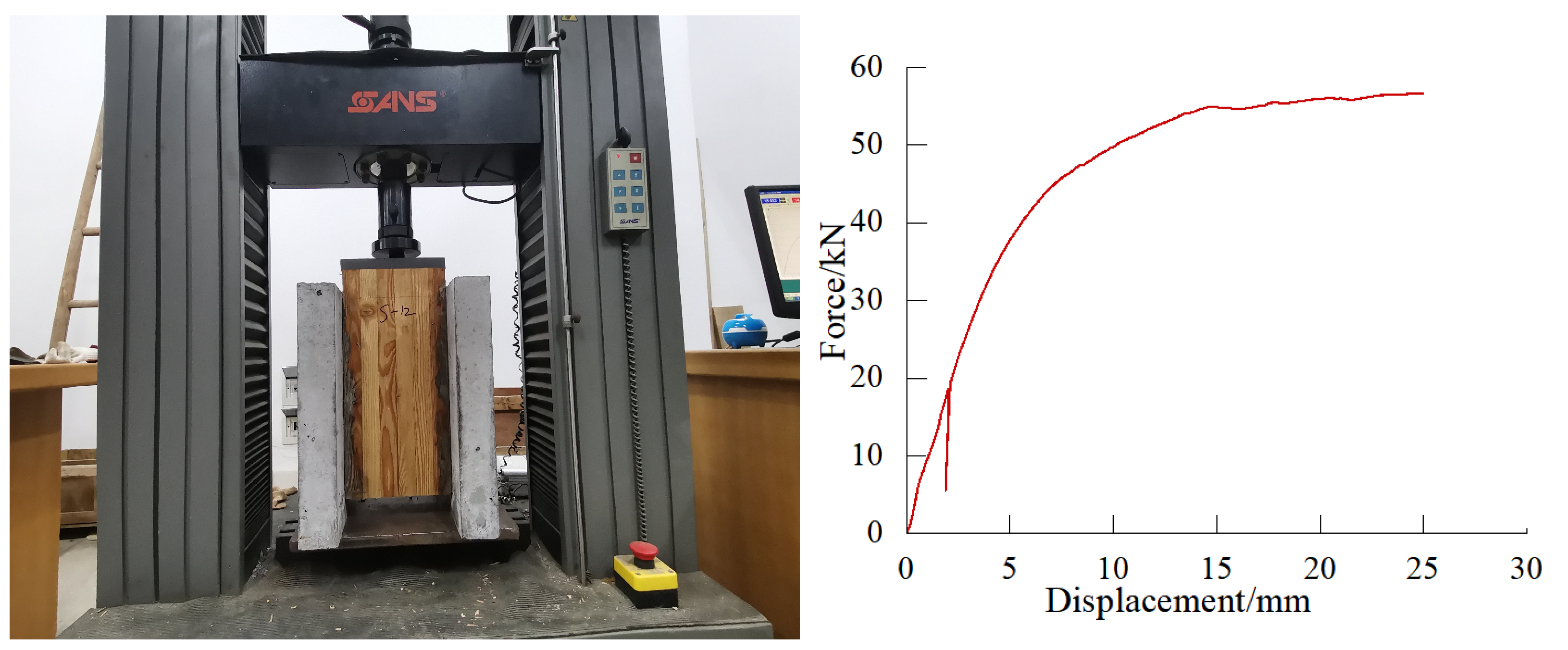
References
- Bjertnaes, M.A.; Malo, K.A. Wind-induced motions of “Treet”-A 14-storey timber residential building in Norway. In Proceedings of the World Conference on Timber Engineering, Quebec City, QC, Canada, 10–14 August 2014. [Google Scholar]
- Flatscher, G.; Schickhofer, G. Life Cycle Tower—High-rise buildings in timber. In Proceedings of the ASCE Structures Congress, Chicago, IL, USA, 29–31 March 2012; pp. 1980–1990. [Google Scholar]
- Mohammad, M. Canada’s Tall Wood Buildings Demonstration projects. In Proceedings of the World Conference on Timber Engineering, Seoul, Republic of Korea, 20–23 August 2018. [Google Scholar]
- Ceccotti, A. Composite concrete-timber structures. Prog. Struct. Eng. Mater. 2002, 4, 264. [Google Scholar] [CrossRef]
- Yeoh, D.; Fragiacomo, M.; De Franceschi, M.; Buchanan, A.H. Experimental tests of notched and plate connectors for LVL-concrete composite beams. J. Struct. Eng. 2011, 137, 261–269. [Google Scholar] [CrossRef]
- Deng, K.; Pan, P.; Su, Y.; Xue, Y.; Dong, H. Behaviour insights on damage-control composite beam-to-beam connections with replaceable elements. J. Constr. Steel Res. 2023, 211, 108174. [Google Scholar]
- Wang, Z.; Zhang, A.; Li, S.; Liu, X. An experimental study of steel-concrete composite connections equipped with fuse angles. Eng. Struct. 2022, 270, 114848. [Google Scholar]
- Chen, X.; Li, H.; Wang, Y. Fatigue enhancement of bolted timber connections using composite reinforcements: Experimental and numerical analysis. Compos. Struct. 2023, 117, 105979. [Google Scholar]
- Rasmussen, P.K.; Sørensen, J.H.; Hoang, L.C.; Feddersen, B.; Larsen, F. Notched connection in timber-concrete composite deck structures: A literature review on push-off experiments & design approaches. Constr. Build. Mater. 2023, 397, 131761. [Google Scholar]
- Estévez-Cimadevila, J.; Martín-Gutiérrez, E.; Suárez-Riestra, F.; Vázquez-Rodríguez, J.; Otero-Chans, D. Timber-concrete composite structural flooring system. J. Build. Eng. 2022, 49, 104078. [Google Scholar] [CrossRef]
- Tao, H.; Yang, H.; Liu, W.; Wang, C. Mechanical behavior of crossed inclined coach screw shear connections for prefabricated timber-concrete composite structures. J. Build. Struct. 2022, 43, 164–174. [Google Scholar]
- Xie, L. Shear Property of Timber-Concrete Composite Structure with Nail Type Connectors. Ph.D. Thesis, Central South University of Forestry and Technology, Changsha, China, 2017. (In Chinese). [Google Scholar]
- Fragiacomo, M.; Amadio, C.; Macorini, L. Short-and long-term performance of the “Tecnaria” stud connector for timber-concrete composite beams. Mater. Struct. 2007, 40, 1013–1026. [Google Scholar] [CrossRef]
- Fernandez-Cabo, J.L.; Arriaga, F.; Majano-Majano, A.; Iñiguez-González, G. Short-term performance of the HSB® shear plate-type connector for timber–concrete composite beams. Constr. Build. Mater. 2012, 30, 455–462. [Google Scholar] [CrossRef]
- Auclair, S.C.; Sorelli, L.; Salenikovich, A. A new composite connector for timber-concrete composite structures. Constr. Build. Mater. 2016, 112, 84–92. [Google Scholar] [CrossRef]
- Du, H.; Hu, X.; Wang, H.; Zhang, J.; Sun, Z. Study on shear performance of oblique screw connectors in glulam-concrete composite structures. J. Build. Struct. 2020, 41, 191–200. [Google Scholar]
- Aldi, P.; Kuhlmann, U. Fatigue strength of timber-concrete-composite bridges: Determination of a s-n-line for the grooved connection and the “x-connector”. In Proceedings of the World Conference on Timber Engineering: WCTE, Riva Del Garda, Italy, 20–24 June 2010. [Google Scholar]
- Balogh, J.; Fragiacomo, M.; Gutkowski, R.M.; Fast, R.S. Influence of repeated and sustained loading on the performance of layered wood–concrete composite beams. J. Struct. Eng. 2008, 134, 430–439. [Google Scholar] [CrossRef]
- Yeoh, D.; Fragiacomo, M.; Carradine, D. Fatigue behaviour of timber-concrete composite connections and floor beams. Eng. Struct. 2013, 56, 2240–2248. [Google Scholar] [CrossRef]
- Yeo, K.J.T.; Yeoh, D.E.C. Stiffness and strength degradation of timber concrete composite under fatigue loading. IOP Conf. Ser. Mater. Sci. Eng. 2020, 713, 012024. [Google Scholar] [CrossRef]
- Zhang, R.; Liu, T.; Kim, S. Machine learning-based damage prediction for bolted joints under seismic loads via digital twin technology. Buildings 2024, 15, 579. [Google Scholar]
- Cao, Y.M.; Peng, L.N.; Chen, Z.A. Dynamic response of wood-hybrid beam bridge under seismic wave action. Hunan Transp. Sci. Technol. 2018, 45, 123–125. [Google Scholar]
- Hossaina, A. Cross-laminated timber connections assembled with a combination of screws. Eng. Struct. 2018, 168, 1–11. [Google Scholar] [CrossRef]
- Aranha, C.A. Finite element modelling of cyclic behaviour of CLT connectors. In Proceedings of the World Conference on Timber Engineering, Vienna, Austria, 22–25 August 2016; pp. 3501–3508. [Google Scholar]
- Sullivan, K.; Miller, T.H.; Gupta, R. Behavior of cross-laminated timber diaphragm connections with self-tapping screws. Eng. Struct. 2018, 168, 505–524. [Google Scholar] [CrossRef]
- Loss, C.; Marchetti, A.; Pessina, S. Numerical study of alternative seismic-resisting systems for CLT buildings. Buildings 2018, 8, 162. [Google Scholar] [CrossRef]
- Ling, Z.B. Bond-Anchorage and Seismic Behaviors of Glulam Joints with Glued-In Rods. Ph.D. Thesis, Southeast University, Nanjing, China, 2015. (In Chinese). [Google Scholar]
- Zheng, W.; Lu, W.; Liu, W. Lateral loading behavior of glulam frame-midply hybrid lateral systems. Constr. Build. Mater. 2019, 220, 53–63. [Google Scholar] [CrossRef]
- Schneider, J.; Karacabeyli, E.; Popovski, M. Damage assessment of connections used in cross-laminated timber subject to cyclic loads. J. Struct. Eng. 2014, 141, 04014188. [Google Scholar] [CrossRef]
- Cao, J.; Xiong, H.; Wang, Z. Experimental investigation and numerical analysis for concrete-CLT connections. Constr. Build. Mater. 2020, 223, 111118. [Google Scholar] [CrossRef]
- Cao, J.; Xiong, H.; Zhang, F.L. Bayesian model selection for the nonlinear hysteretic model of CLT connections. Eng. Struct. 2020, 223, 111118. [Google Scholar] [CrossRef]
- Shahnewaz, M.; Pan, Y.; Shahria Alam, M.; Tannert, T. Seismic fragility estimates for cross-laminated timber platform building. J. Struct. Eng. 2020, 146, 04020256. [Google Scholar] [CrossRef]
- Žarnić, R.; Rajčić, V.; Kržan, M. Response of laminated glass-CLT structural components to reverse-cyclic lateral loading. Constr. Build. Mater. 2020, 235, 117509. [Google Scholar] [CrossRef]
- Li, J.; Bai, F.; Wang, Y.S. Study on Seismic Damage Evolution Model of Through Tenon Joints in Ancient Timber Structures. J. Build. Struct. 2024, 54, 146–152. [Google Scholar]
- Dong, J.; Bai, Y.H.; Liu, Y.H. Seismic damage performance of novel prefabricated frame joints. J. Vib. Shock. 2024, 43, 267–277. [Google Scholar]
- Tao, H.T.; Yang, H.F.; Zhou, Z.X. Influence of slab composite effect on the seismic performance of timber-concrete composite structures. J. Build. Eng. 2025, 101, 111815. [Google Scholar] [CrossRef]
- Tao, H.; Yang, H.; Tang, L. Seismic Performance of Joint between Timber-Concrete Composite Beams and Steel Column. J. Struct. Eng. 2023, 149, 555–565. [Google Scholar] [CrossRef]
- Tao, H.T.; Yang, H.F.; Wu, Y.S.; Ju, G.Y.; Liu, J.W.; Shi, B.K. Seismic performance of timber moment-resisting frame with timber-steel hybrid joints. Structures 2025, 71, 108070. [Google Scholar] [CrossRef]
- EN 1994 Eurocode 4; Design of Composite Concrete and Steel Structures. European Committee for Standardization: Brussels, Belgium, 2005.
- GB/T 50107-2010; Standardization Administration of China. Standard for Inspection and Assessment of Concrete Strength. China Standards Press: Beijing, China, 2010.
- GB/T 1927.11-2022; Standardization Administration of China. Test Methods for Physical and Mechanical Properties of Small Clear Wood Specimens—Part 11: Determination of Compressive Strength Parallel to Grain. China Standards Press: Beijing, China, 2022.
- Huang, J. Seismic Performance of Composite Columns with Steel-Concrete Hybrid Tubes. Master’s Thesis, Wuhan University, Wuhan, China, 2009. (In Chinese). [Google Scholar]
- Zhang, X.C.; Hu, C.M.; Wu, C.W.; Han, Y.N.; Zhang, Y.T. Research on seismic performance of shape memory alloy reinforced mortise-tenon joints. Eng. Mech. 2022, 39, 164–176. [Google Scholar]
- Li, C.C.; Liu, W.Q.; Ou, J.; Lu, W.D.; Yang, H.F. Experimental study on seismic performance of timber frame structure with beam-column columns. Jiangsu Archit. 2010, 3, 61–63. [Google Scholar]
- Kraetzig, W.; Meyer, I.; Meskouris, K. Damage evolution in reinforced concrete members under cyclic loading. In Proceedings of the 5th International Conference on Structural Safety and Reliability, Barcelona, Spain, 14–15 August 2025; ASCE: Reston, VA, USA, 1989; pp. 795–802. [Google Scholar]
- ASTM E2126-11; Standard Test Methods for Cyclic Load Test. ASTM: West Conshohocken, PA, USA, 2009.
- ASCE/SEI 41-17; Seismic Evaluation and Retrofit of Existing Buildings. American Society of Civil Engineers: Reston, VA, USA, 2017.
- Price, A.T. A mathematical discussion on the structure of wood. Philos. Trans. R. Soc. 1929, 228, 1–62. [Google Scholar]
- Zhou, T.M. Parametric study on structural behavior of skewed-inverted-T bent caps. J. Bridge Eng. 2020, 25, 04020092. [Google Scholar] [CrossRef]
- Filiatrault, A.; Christovasilis, I.P.; Wanitkorkul, A.; van de Lindt, J.W. Seismic loss estimation of wood-frame buildings based on residual drift ratios. Earthq. Spectra 2010, 26, 573–592. [Google Scholar]
- BS EN 26891; Timber Structures-Joints Made with Mechanical Fasteners-General Principles for the Determination of Strength and Deformation Characteristics. British Standards Institution: London, UK, 1991.
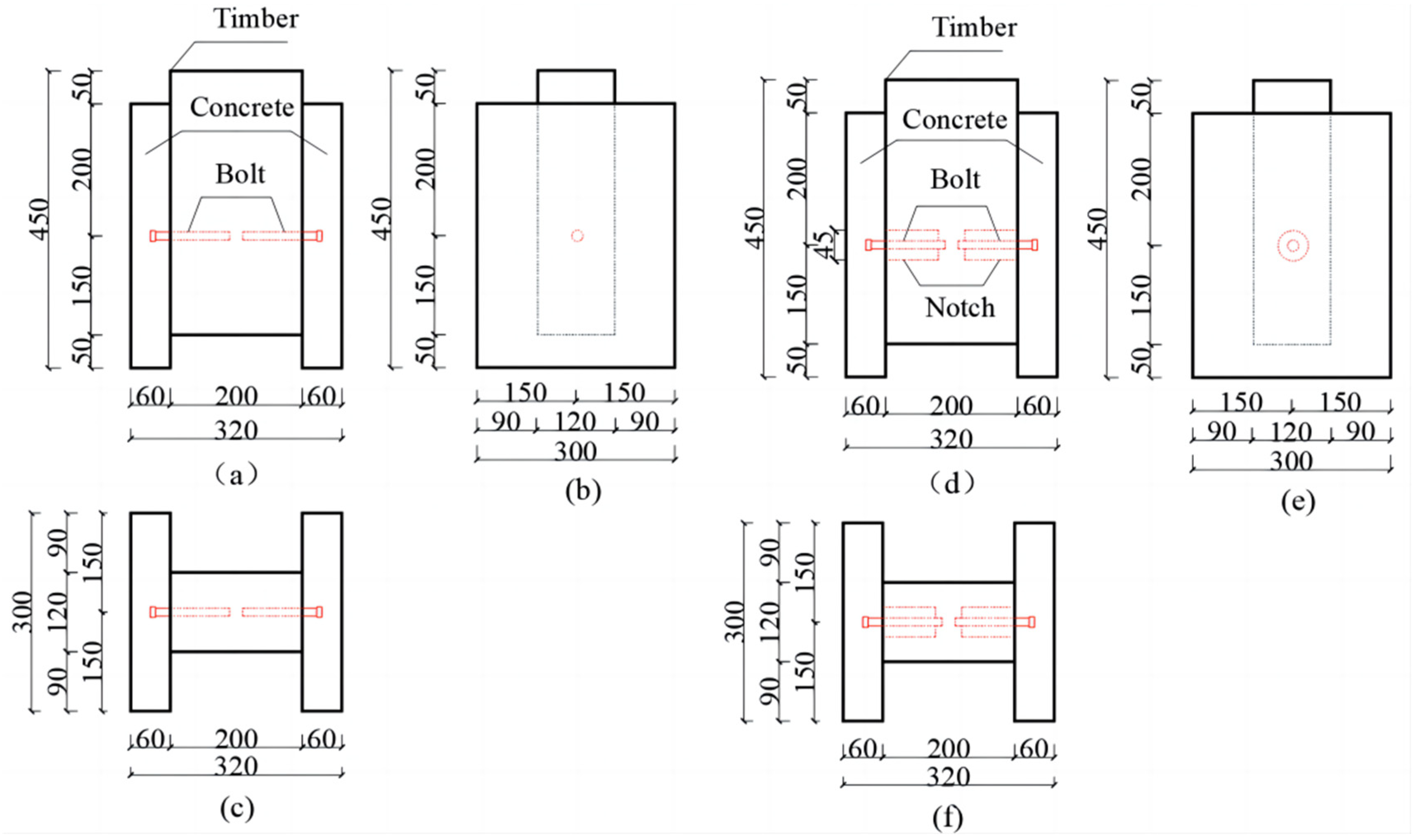


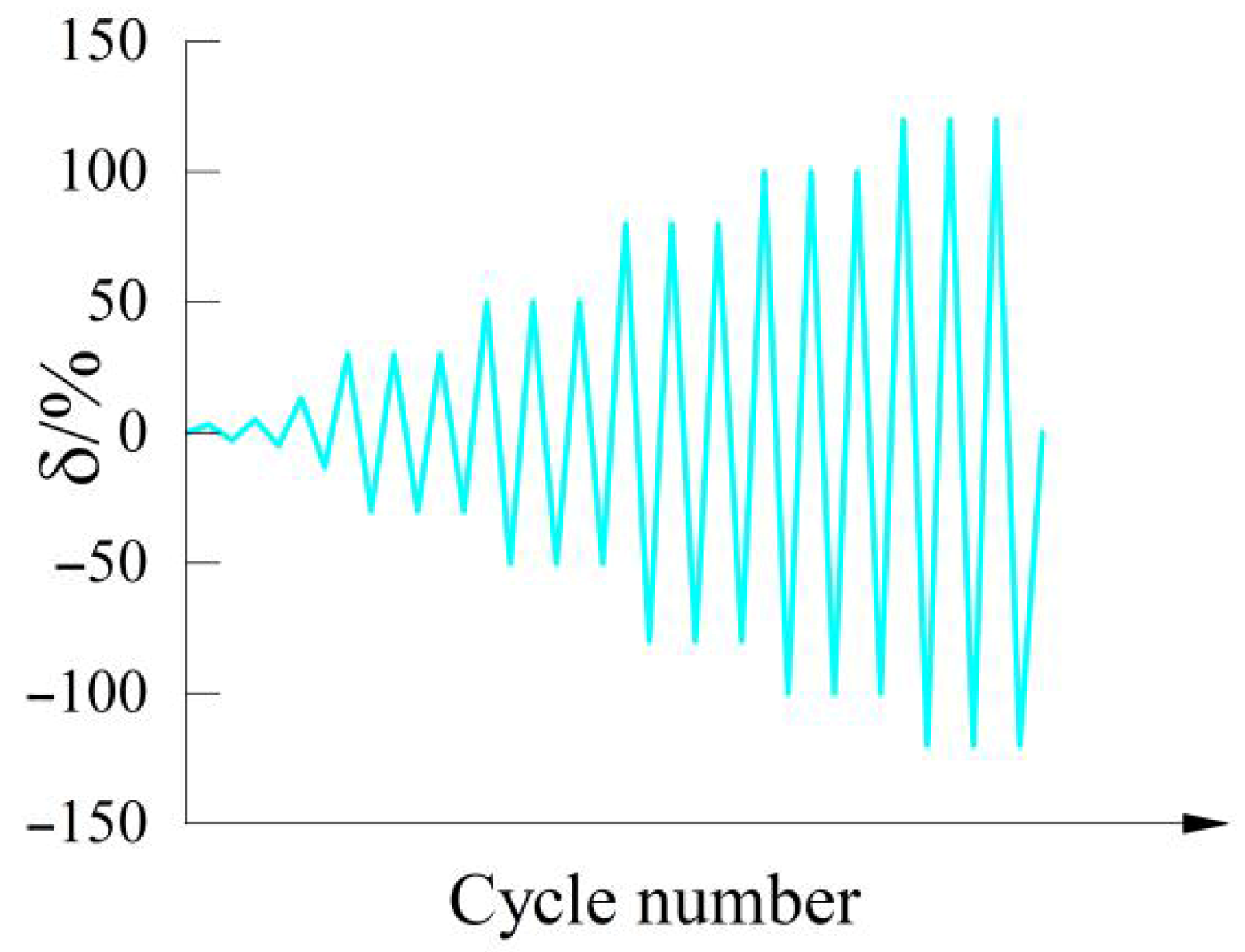


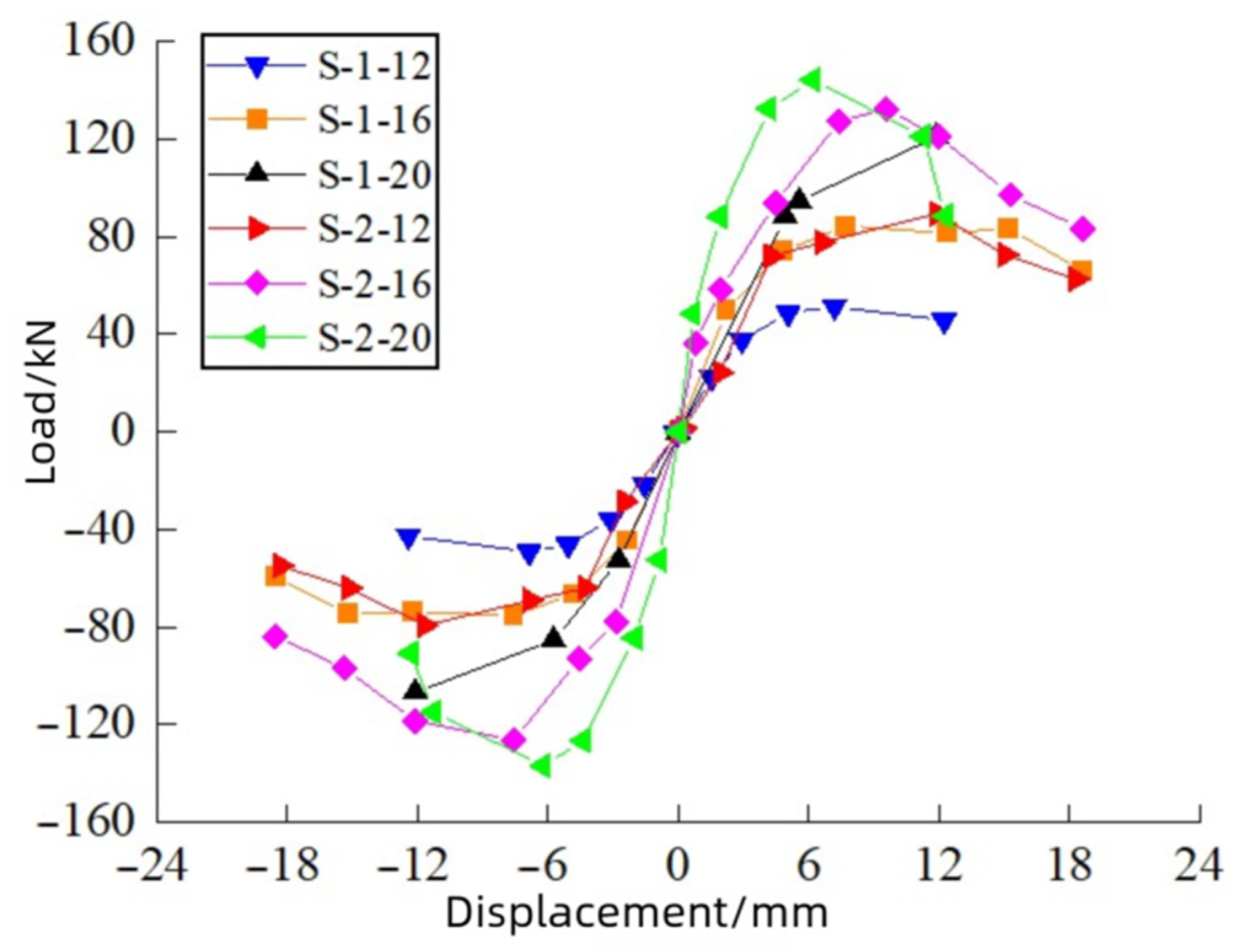

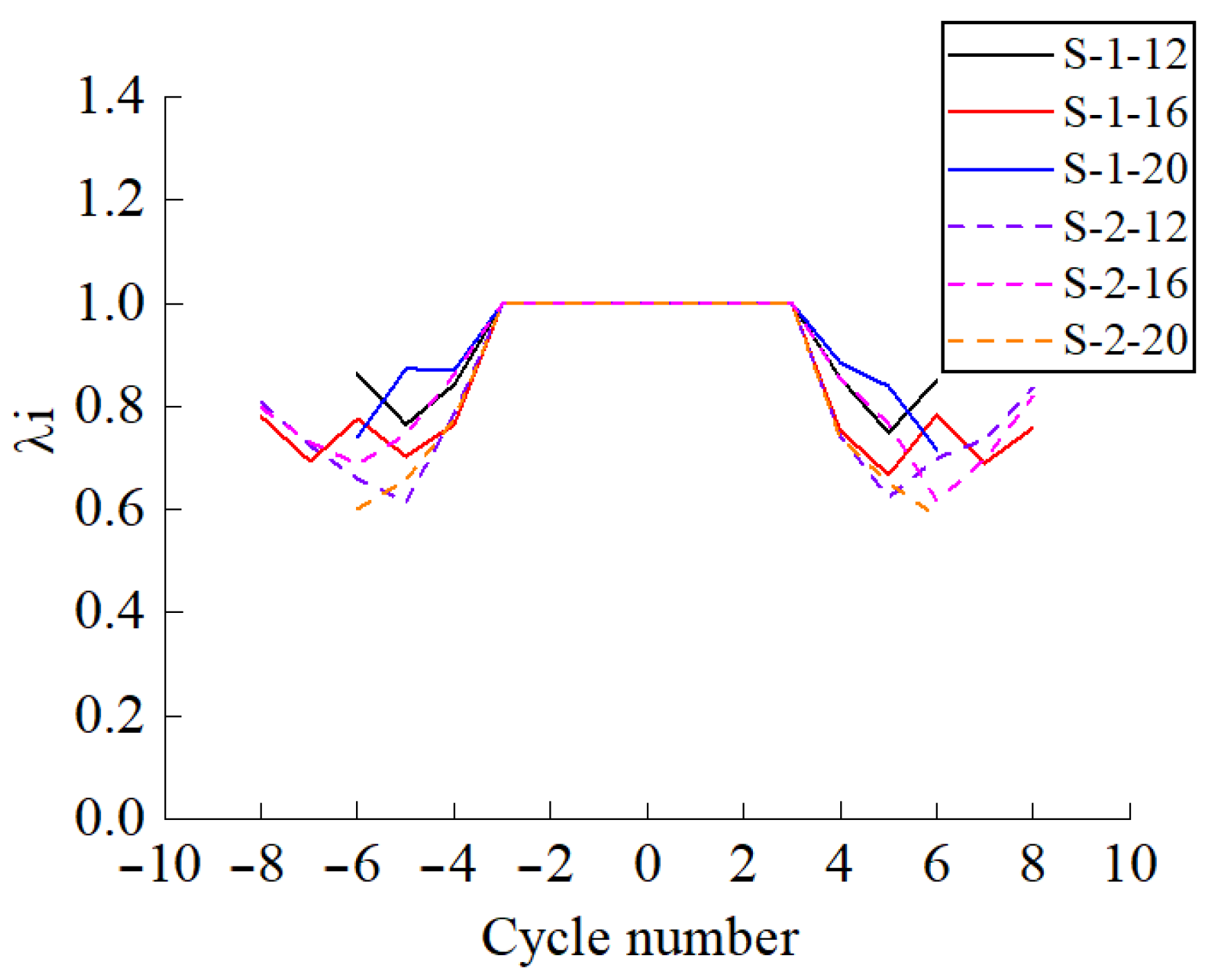
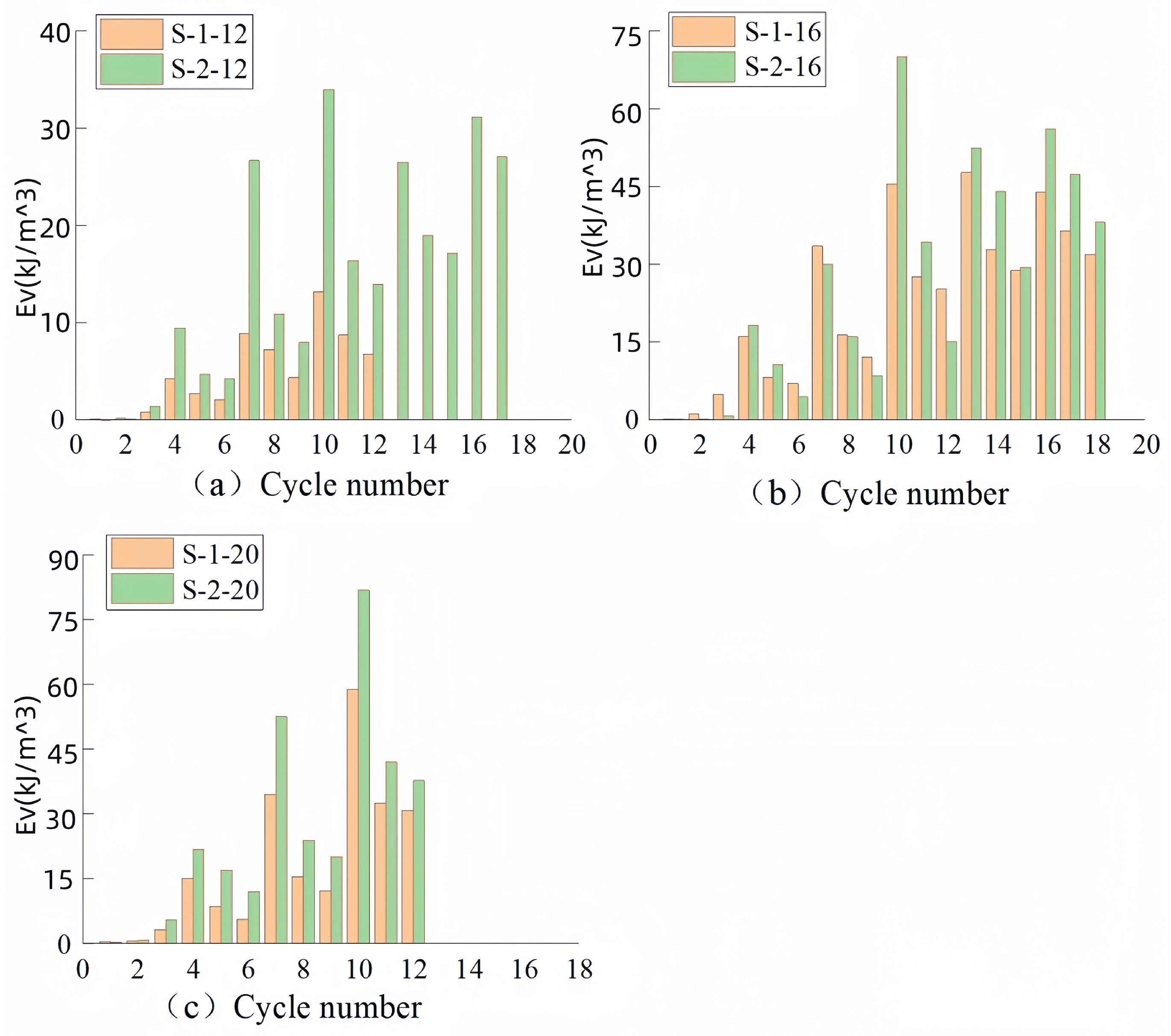

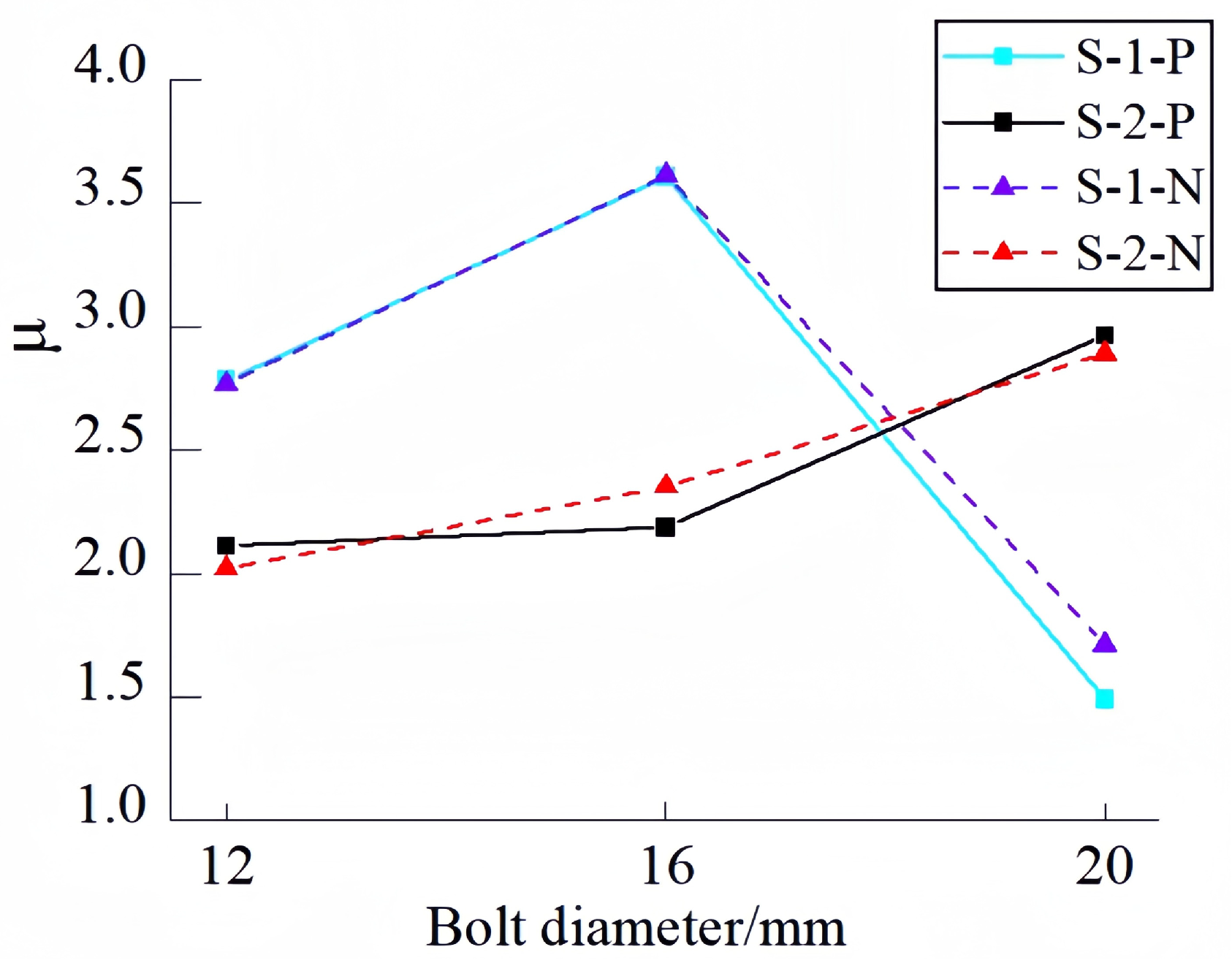




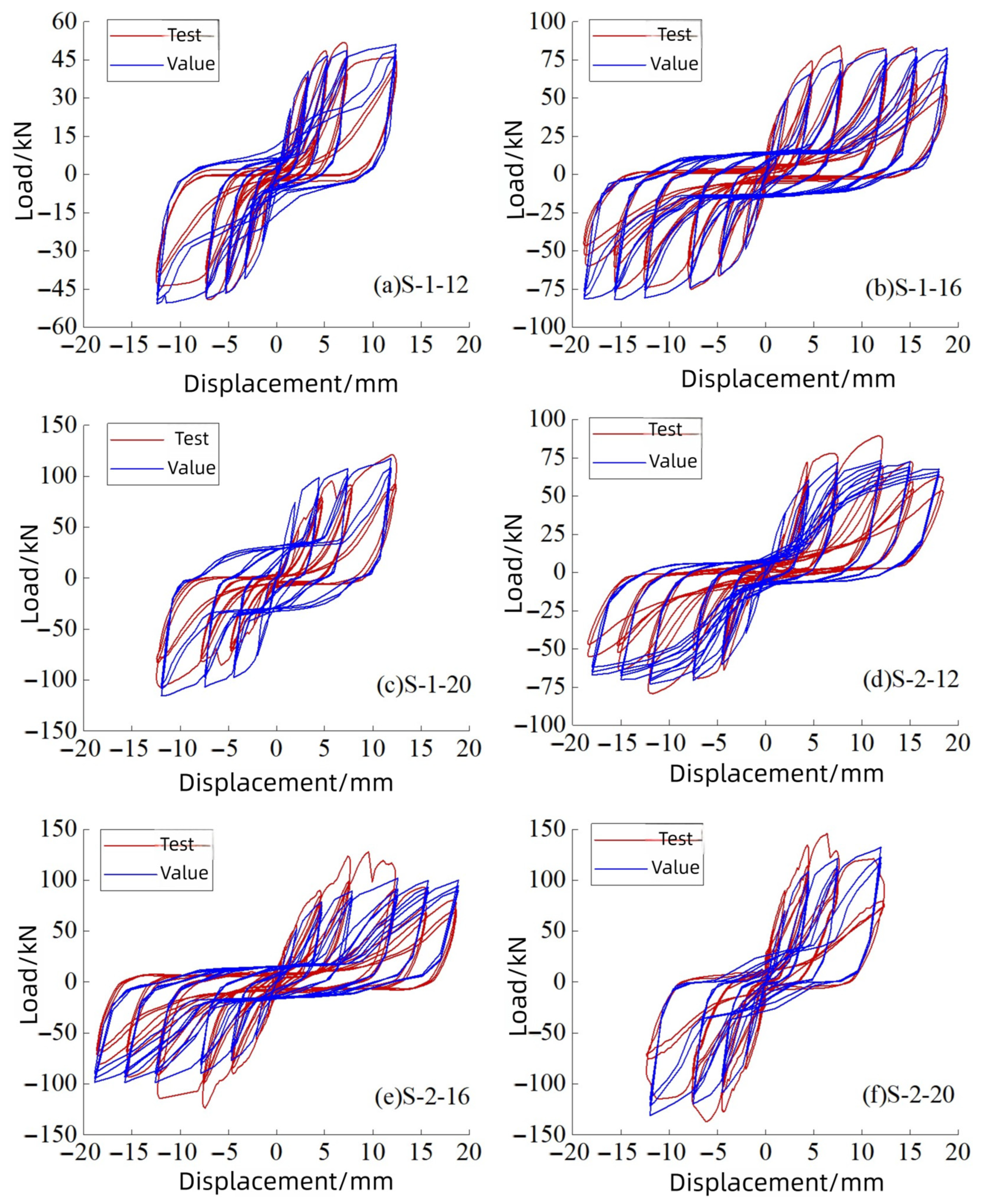

| Connection ID | Bolt Diameter/mm | Connector Type | The Depth of Bolt in the Timber/mm | The Depth of Bolt in the Concrete/mm |
|---|---|---|---|---|
| S-1-12 | 12 | bolts | 90 | 30 |
| S-1-16 | 16 | |||
| S-1-20 | 20 | |||
| S-2-12 | 12 | notched bolts | ||
| S-2-16 | 16 | |||
| S-2-20 | 20 |
| Connection ID | Compressive Strength of Concrete/MPa | Tensile Strength of Timber /MPa | Elasticity Modulus of Timber/GPa | Yield Strength of Stud/MPa | Ultimate Tensile Strength of Stud/MPa |
|---|---|---|---|---|---|
| S-1-12 | 32.24 | 30.42 | 12.32 | 640 | 800 |
| S-1-16 | |||||
| S-1-20 | |||||
| S-2-12 | |||||
| S-2-16 | |||||
| S-2-20 |
| Cycle Number | Repetition | Amplitude/% | Displacement/mm |
|---|---|---|---|
| 1 | 1 | 3 | 0.4 |
| 2 | 1 | 5 | 0.8 |
| 3 | 1 | 13 | 2 |
| 4 | 3 | 30 | 4.5 |
| 5 | 3 | 50 | 7.5 |
| 6 | 3 | 80 | 12 |
| 7 | 3 | 100 | 15 |
| 8 | 3 | 120 | 18 |
| Connection ID | Δy | Fm (kN) | Ke (kN/mm) | Fy (kN) | ||||
|---|---|---|---|---|---|---|---|---|
| Positive | Negative | Positive | Negative | Positive | Negative | Positive | Negative | |
| S-1-12 | 4.4 | 4.5 | 51.4 | 49.2 | 14.5 | 12.7 | 45.1 | 43.2 |
| S-1-16 | 5.2 | 5.1 | 84.2 | 75.0 | 22.3 | 19.1 | 74.2 | 66.7 |
| S-1-20 | 8.0 | 7.1 | 121.0 | 106.8 | 17.9 | 21.5 | 104.5 | 89.8 |
| S-2-12 | 8.7 | 9.1 | 89.2 | 79.4 | 13.7 | 21.5 | 78.1 | 69.8 |
| S-2-16 | 8.5 | 7.9 | 131.9 | 126.1 | 45.4 | 27.1 | 111.5 | 107.2 |
| S-2-20 | 4.2 | 4.3 | 144.1 | 136.9 | 70.1 | 60.9 | 122.3 | 115.6 |
| Connection ID | Δ (mm) at Failure | Failure Description | Damage Index |
|---|---|---|---|
| S-1-12 | 12.449 | Concrete separated from timber; Timber crushed | 0.613 |
| S-1-16 | 17.036 | Concrete cracked and separated from timber; Timber crushed | 0.787 |
| S-1-20 | 11.592 | Concrete cracked and separated from timber; Timber crushed | 0.850 |
| S-2-12 | 15.046 | Concrete separated from timber; Timber remained intact | 0.603 |
| S-2-16 | 12.283 | Concrete cracked and separated from timber; Timber remained intact | 0.768 |
| S-2-20 | 11.585 | Concrete cracked and separated from timber; Timber remained intact | 0.836 |
| Element | Normal Penalty Stiffness Factor | Penetration Tolerance Factor | Initial Contact Closure | Coefficient of Friction |
|---|---|---|---|---|
| CONTA174 | 0.1 | 0.1 | 0.01 | 0.2 |
| Materials | Elastic Modulus (MPa) | Poisson’s Ratio | Strength (MPa) |
|---|---|---|---|
| Concrete | 30,000 | 0.2 | 32.24 (Compressive strength) |
| Timber | 12,320 | 0.37 | 30.42 (Compressive strength) |
| Bolt | 200,000 | 0.3 | 640 (Yield strength of stud) |
Disclaimer/Publisher’s Note: The statements, opinions and data contained in all publications are solely those of the individual author(s) and contributor(s) and not of MDPI and/or the editor(s). MDPI and/or the editor(s) disclaim responsibility for any injury to people or property resulting from any ideas, methods, instructions or products referred to in the content. |
© 2025 by the authors. Licensee MDPI, Basel, Switzerland. This article is an open access article distributed under the terms and conditions of the Creative Commons Attribution (CC BY) license (https://creativecommons.org/licenses/by/4.0/).
Share and Cite
Zheng, Z.; Yuan, S.; He, G. Experimental and Design Research on Seismic Performance of Connectors in Timber–Concrete Composite Structures. Buildings 2025, 15, 3084. https://doi.org/10.3390/buildings15173084
Zheng Z, Yuan S, He G. Experimental and Design Research on Seismic Performance of Connectors in Timber–Concrete Composite Structures. Buildings. 2025; 15(17):3084. https://doi.org/10.3390/buildings15173084
Chicago/Turabian StyleZheng, Zuen, Shuai Yuan, and Guojing He. 2025. "Experimental and Design Research on Seismic Performance of Connectors in Timber–Concrete Composite Structures" Buildings 15, no. 17: 3084. https://doi.org/10.3390/buildings15173084
APA StyleZheng, Z., Yuan, S., & He, G. (2025). Experimental and Design Research on Seismic Performance of Connectors in Timber–Concrete Composite Structures. Buildings, 15(17), 3084. https://doi.org/10.3390/buildings15173084




